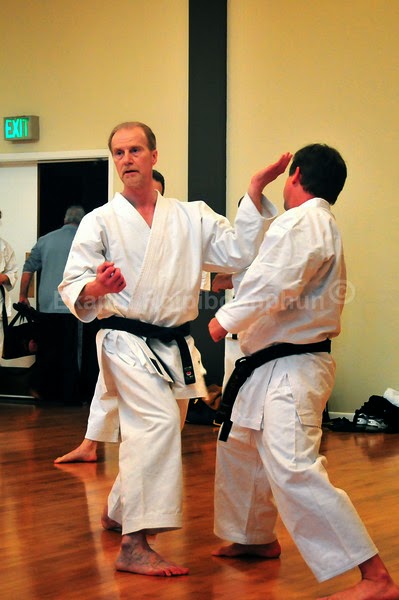Last
Thursday through Sunday, our dojo hosted a 4-day training camp run by the World
Traditional Karate Organization, our parent dojo. The first one was last year in Switzerland,
and the second one was in our laps, in Cupertino, California. We had instructors and participants from
several countries attend.
Within
those four days were a belt test, a tournament, and about 14 hours of training. Each training session was about 90 minutes
long, and could have one, two, or three different instructors, taking different
groups/levels of students.
I came
away with a few things that relate directly to taiko, and wanted to talk about
them over a couple of posts:
1.
Relax!
I saw
magic happen at the camp. One of our
highest-ranking instructors, Ubl-sensei,
demonstrated techniques with blinding speed that was only possible by his mastery of relaxation. I’ve seen a crapload of
techniques in person and online and have never seen the speed (or ease of
motion) that man possesses. Using the
body to power techniques is important, but as soon as there’s tension, you’ve
reduced your speed. Ubl-sensei’s
techniques were not large motions, yet they were explosive and knocked people
around as if he hit them with a club.
In
taiko, the ability to relax is underrated.
I see so much tension when I watch people play. It affects everything, from the quality of
sound to grace of motion and all the bits in between. It’s one thing to be really tired after a
long solo/song, to be pushing yourself hard at the end and not being able to
relax, but I’m talking about someone who’s fresh and playing for even a few
minutes. Tension is your enemy and
sometimes you have to have someone point out where you’re holding it. We all gotten used to what “feels”
natural, but that’s like when the body “accepts” a certain level of a pain as being the norm over
the long-term. You may not know that you're holding that tension even as it's obvious to someone watching.
Taiko
tends to have a lot of “unnecessary motion”, because we’re often trying to make
it visually enjoyable. But when it comes to striking the drum, you don’t want
extra twitches or flourishes that aren’t dictated by style.
For a
comparison, take a basic punch vs. a basic (taiko) strike. Launching the punch from the body means it’ll
be faster and stronger, sure. But what
happens on impact or at the end of the technique? Most karate students either hold the punch out there with tension or pull the elbow (or fist)
back to the hip and tense up because it "feels" right. But what then when you want to strike with that limb twice? You then have to relax it after tensing it. Wasted motion and wasted effort. Not saying it's easy to make it happen; it takes work to be relaxed and yet move with speed.
For a drum strike, using the body to generate power is probably the most efficient method, and then there’s
impact against the head. A lot of
players grip really tight at that moment, either muffling the quality/amount of volume possible,
or right after, over-controlling the bachi. Yes, you don’t want the rebound to cause
floppy pathways, but then how do you train to play a sequence of fast notes if
you’re trying to choke that sucker to death after each hit?
Relaxation
also benefits small motions. It’s a lot
easier to make a big noise on taiko when you’re coming from an arm’s-length
away, just like it’s “easier” to do damage to someone who lets you throw a
punch from a mile away. But both become
very limited, very quickly. If you know how to
immediately squeeze and release
using the core muscles and everything connected to them, you can get a really
loud sound from a bachi only an inch
off the drum head. Same goes for a
blocking or punching technique, doing serious impact without the need for winding up or
pulling back.
Making
relaxation a focus in your training is something you have to individually be
vigilant about. Your instructors can
point tension out to you, but only you can work at reducing it.
More insights in future posts!

No comments:
Post a Comment